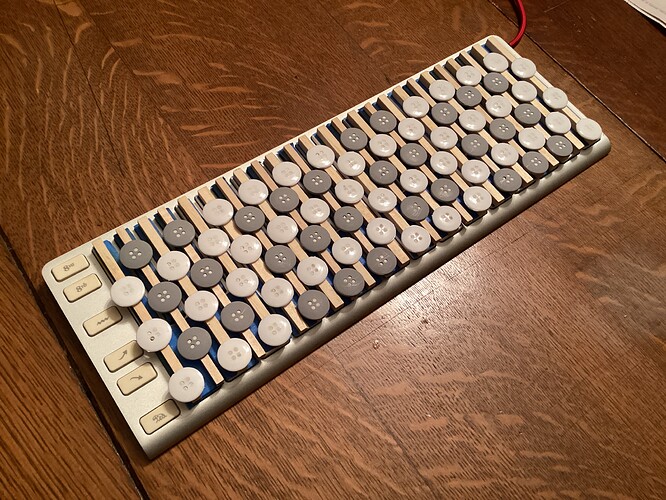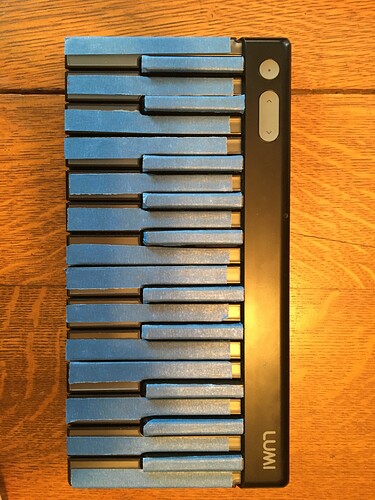Hello, All. I am in the midst of a two-week hobby-shopping binge, and have converted my XKey 25 (no Bluetooth) to Janko with excellent results. Almost full-sized keys, fast and light, all keys with same fingering, and on and on. I wish I had started with this sort of thing!
I am about 25% done with the Lumi conversion, and if it works as well as the XKey, I’ll have full MPE and Bluetooth with the iPhone or iPad, and that extra dimension of expressivity beyond the XKey. But then, I’ll have to make a big (200 dollar, plus) decision about the “ultimate” (to simple me) portable setup. Do I add another Lumi and modify it so I have a combined 4 octaves, and all Janko? Do I settle for a more resrained 37 key XKey? Do I just use the Lumi in my left, and the XKey in the right, or vice versa? That would give me four octaves, but the key spacing and button size will be a bit smaller for the Lumi, so might make it feel strange.
Anyway, has anyone gotten the pair of Lumi boards and played them together? Played them separate, like a split computer keyboard? Both sides, like an accordion? Is there anyway to cable them together, rather than mag/snap via the DNA connectors? I might want to be more flexible in positioning them.
By the way, all this makes me feel rather like I am cheating on my Striso! It really answers about all of the questions “as is”, so I guess I am just keeping busy until I hear from Piers Titus or other reliable sources that Striso will continue to be produced and delivered. These others are my backup, so to speak.
1 Like
I have the version from Kickstarter and there the connectors were a little hit-and-miss. Have heard the new ones work a lot better though.
The Janko conversion sounds interesting! Could you please post a photo?
1 Like
Sure. Here’s photos, I hope. One is finished and playable XKey, other LumiKey prepped for sticks and buttons. Hope to finish that one in the next day or two. The “Jancolpitts” method is non-destructive to the platform; removable painter’s tape on the plastic keys, then glue the wooden sticks (one height for black and another for white) so all are same width and height. Then affix buttons. 6 rows for XKey and just about ideal “feel.” When I am certain everything is good, I’ll be able to re-do with permanent adhesive to the controller keys, but this way doesn’t even void the warranty, I bet.
5 Likes
Cool, creative solution!
That shows that the piano keyboard is technically isomorphic - if you just play high enough at the top of the keys 
1 Like
Thank you. I can’t wait for the Lumi to be done. I’ll post a picture when it is.
1 Like
Too late to post the pic of the Lumi, and frankly, a bit of a mixed blessing. It does, in fact, work rather seamlessly, although I had to make some button modifications to allow them to fit and work smoothly. The other hand, it really isn’t as responsive for fast play as the XKey Jancolpitts is; I can “dig in” and get the cool responses and extra dimensions, as they say, but it is just a bit slower and stuffier. So, it might be my “bass” end when used with the XKey, but I need to figure that out. I am leaning towards spending money (not like me…) on a new 37 key XKey. We’ll see.
1 Like
I am honestly also not too keen on the action of the Lumi. Think the LED-overlays are a nice, novel idea, but if one doesn’t need/use that then there are other poly-aftertouch keyboards on the market now.
You could try an Osmose  (The feel of the Osmose keys is also different to most other keyboards, needs some getting used to. But very predictable imho.)
(The feel of the Osmose keys is also different to most other keyboards, needs some getting used to. But very predictable imho.)
When it comes to portable mini-keys with integrated synth (that can also be driven via a bigger midi master keyboard occasionally) I like the Yamaha Reface series. No aftertouch thouch, just normal keys.
1 Like

